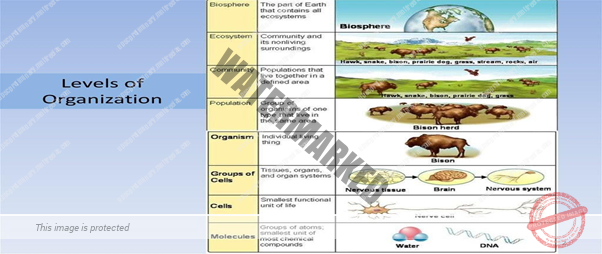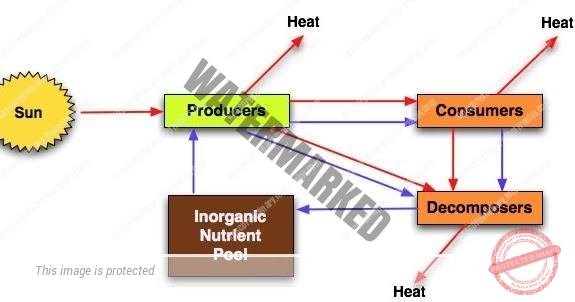- INTRODUCTION TO ECOLOGY & ECOSYSTEM
- ECOLOGY
- LEVELS OF BIOLOGICAL ORGANIZATION
- COMMON CHARACTERSTICS OF ECOSYSTEM BY SMITH (1966)
- ECTONE
- STRUCTURE OF ECOSYSTEM
- ABIOTIC FACTORS
- BIOTIC FACTORS
- CHEMAUTOTROPHS
UNIT 1 – ECOLOGY & ECOSYSTEM – PART 1
Learning outcomes:
In this unit you will be able to learn the following: The concept of ecology, ecosystem, and its related phenomena.
INTRODUCTION To ECOLOGY & ECOSYSTEM
Our living world is fascinatingly diverse and amazingly complex. Our earth’s life support system consists of four main components –
- The Geosphere
- The atmosphere
- The Hydrosphere
- The Biosphere.
We can try to understand its complexity at various levels of biological organization–Macromolecules, Cells, Tissues, Organs, Individual Organisms, Population, Communities, Ecosystems and Biomes. These communities and its interaction with the environment accounts for the subject matter of study under ecology and environment.
ECOLOGY
Definition:
Ecology is the scientific study of organisms with their surroundings i.e., the physical environment and within themselves. The term ‘Ecology’ was first coined by the German biologist Ernst Haeckel in 1869.
Haeckel defined ecology as ‘the study of natural environment including the relations of organisms to one another and to their surroundings.’ It is derived from two Greek words – “oikos” meaning home and “logos” meaning study.
Thus literally, ecology is the study of life at home with main emphasis on pattern of relations between organisms and their surrounding environment.
Ecology can also be considered in terms of concept of levels of organization. The entire biological spectrum can at the best be divided into ten levels of organization including Atom, Cell, Organ & Organ System.
The ecologists study interactions within and among six of these levels –
- Organisms
- Populations
- Communities
- Ecosystems
- Biomes
- Biosphere.
Levels of Biological Organization
ECOSYSTEM
Organisms interact with one another and with their environment in a number of ways. These fundamental interactions among organisms and their non-living/physico-chemical environment constitute an interrelating and interdependent ever-changing system known as an ecological system or ecosystem.
Therefore, ecosystem can be defined as a functional unit of nature, where living organisms interact among themselves and also with the surrounding physical environment. The term ‘Ecosystem’ was first coined in 1935 by the British ecologist Sir Arthur G. Tansley.
COMMON CHARACTERISTICS OF ECOSYSTEM BY SMITH (1966):
- The ecosystem is the major Structural & Functional unit of Ecology
- The structure of an ecosystem is related to its Species Diversity; the more complex ecosystems have high species diversity.
- Ecosystems mature by passing from less complex to more complex stages. Early stages of such succession have an excess of potential energy and a relatively high energy flow per unit biomass
- Alterations in the environment represent selective pressures upon the population to which it must adjust. Organisms which are unable to adjust to the changed environment disappear ultimately.
- All ecosystems have a feeding hierarchy which starts with an energy source (e.g., the sun) and then followed by Producers, Consumers & Decomposers. These components are dependent on one another. One of the important features is presence of Grazing or Detritus Food Chain and Food Webs which become the lifeline of ecosystems.
- Ecosystems are sustained by the presence of biodiversity. Each organism in an ecosystem has a purpose (i.e., niche), as a result, the loss of one species can alter both the size and stability of ecosystems.
ECOTONE
Ecotone is a transitional area of vegetation between two different communities, such as Forest and Grassland. It has some of the characteristics of each bordering biological community and often contains species not found in the overlapping communities.
An Ecotone often has a higher density of organisms of one species and a greater number of species than are found in either adjacent community. Some organisms need a transitional area for activities such as courtship, nesting, or foraging for food.
Ecotones also appear where one body of water meets another (e.g., Estuaries And Lagoons) or at the boundary between the Water And The Land (e.g., marshes). Freshwater & Marine Ecotone is characterized by the presence of large plants that rise from roots attached to the submerged substrate, and thus they occur in areas where ample light is available at the bottom of the basin to permit growth.
STRUCTURE OF ECOSYSTEM
Abiotic Biotic
The ecosystem is largely divided into two components – Abiotic and Biotic components. Ecosystem structure is created due to interaction between Abiotic & Biotic components, varying over space and time.
The structure of ecosystem is composed of the following components:
ABIOTIC FACTORS
They mainly include
- Inorganic substances – such as Carbon Dioxide, Water, Nitrogen, Calcium, Phosphorus, etc. that are involved in material cycles. The amount of these inorganic substances present at any given time in ecosystem is called as Standing State or Standing Quality Of Ecosystem.
- Organic Compounds – Proteins, Carbohydrates, Amino Acids, Lipids, Humic substances and others are synthesized by the biotic counterpart of an ecosystem. They make biochemical structure of ecosystem.
- Climatic Factors – Rain, Light, Temperature, Humidity, Wind and Air
- Other factors – such as Minerals, Soil, Topography, Ph, etc. greatly determine the functions, distribution, structure, behavior and inter-relationship of organisms in a habitat.
BIOTIC FACTORS
The biotic components of the ecosystems living are the organisms including plants, animals and microorganisms. These biotic factors are classified according to their role in the ecosystem as:
- Producers Or Autotrophs –these are the green plants with chlorophyll which gives them the ability to use solar energy to manufacture their own food using simple inorganic abiotic substances, through the process of photosynthesis.
For e.g. Green Plants, Herbs, Shrubs, Trees, Phytoplankton’s, Algae, Mosses, etc. bacteria beneath in the ocean which can synthesize their food in absence of sunlight, thus known as Chemoautotrophs
- Consumers or Heterotrophs – It includes
- 1. Herbivorous (feed on Plants).
- 2. Carnivorous (feed on other Animals).
- 3. Omnivorous (feed on both Plants & Animals) and
- 4. Detritivore’s organisms (feed on Dead Parts, Waste, Remains, of plants and animals.
- Decomposers Or Saprotrophs – The Microorganisms, Bacteria & Fungi, which break down complex dead organic matter into simple inorganic forms, absorb some of the decomposition products, and release inorganic nutrients that are reused by the producers.
Therefore, all ecosystems have their own set of producers, consumers and decomposers which are specific to that ecosystem.


